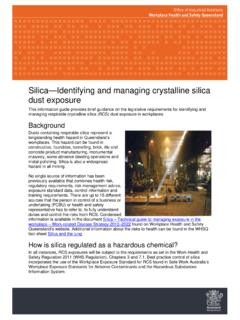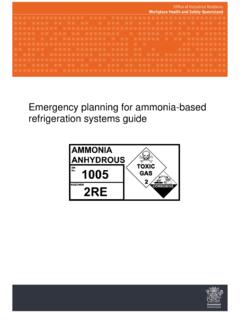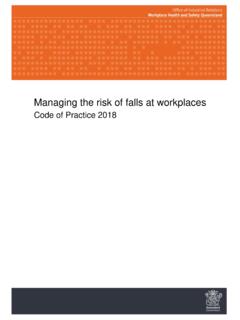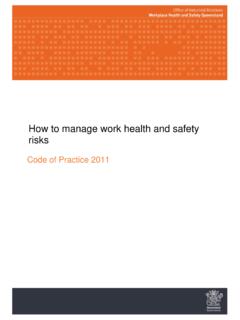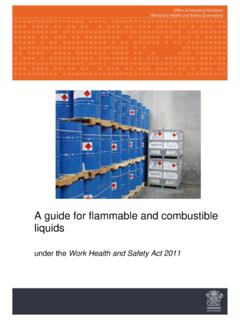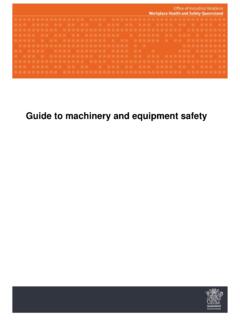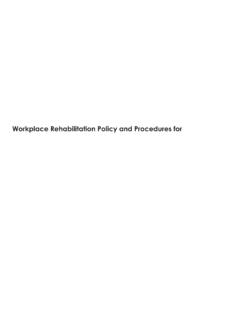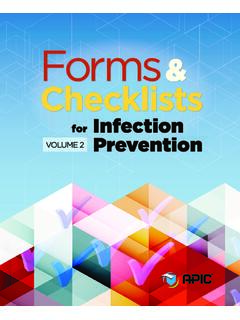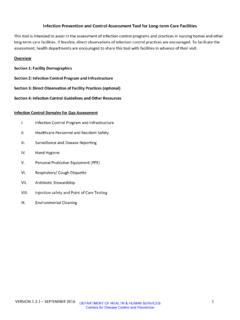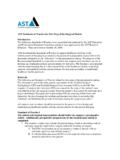Transcription of Managing respirable crystalline silica dust exposure in ...
1 Managing respirable crystalline silica dust exposure in the stone benchtop industry Code of Practice 2019. This Queensland code of practice has been approved by the Minister for Education and Minister for Industrial Relations under section 274 of the Work Health and Safety Act 2011 and will commence on 31. OCTOBER 2019. PN12527. The State of Queensland 2019. Copyright protects this document. The State of Queensland has no objection to this material being reproduced, but asserts its right to be recognised as author of the original material and the right to have the material unaltered. The material presented in this publication is distributed by the Queensland Government as an information source only. The State of Queensland makes no statements, representations, or warranties about the accuracy or completeness of the information contained in this publication, and the reader should not rely on it.
2 The Queensland Government disclaims all responsibility and all liability (including, without limitation, liability in negligence) for all expenses, losses, damages and costs you might incur as a result of the information being inaccurate or incomplete in any way, and for any reason. PN12527. Managing respirable crystalline silica dust exposure in the stone benchtop industry Code of Practice 2019 Page 2 of 48. Contents 1. 5. Scope and application .. 5. 2. Introduction .. 5. 3. Consultation .. 8. Consulting with workers and the role of workers .. 8. Consulting, cooperating and coordinating activities with other duty holders .. 9. 4. Duties of manufacturers, importers and suppliers of stone 9. Manufacturers .. 10. Importers and suppliers.
3 10. 5. Planning for stone benchtop fabrication and installation .. 11. What is the workplace exposure standard for respirable crystalline silica dust?.. 12. Prohibition on uncontrolled dry cutting/processing .. 13. Developing a respirable crystalline silica dust control 13. 6. Identifying respirable dust hazards .. 14. Fabrication workers and others at risk .. 15. Air monitoring .. 16. 7 Controlling respirable crystalline silica dust risks .. 19. The hierarchy of control measures .. 19. Water suppression .. 20. Local exhaust ventilation (LEV) .. 20. Natural ventilation .. 21. Prevent workers breathing in dust .. 22. Enclose water suppression processes .. 22. Isolating workers .. 23. Administrative controls to minimise exposure .
4 23. Use Respiratory Protective Equipment .. 24. Clean up .. 29. Workers' clothing .. 30. Housekeeping .. 30. Wet slurry and recycled water .. 31. Reviewing control measures .. 32. Daily and routine checks .. 32. Review and revision of controls .. 32. 8. Installing stone benchtops .. 33. 9. Health monitoring .. 35. 10. Information, training, instruction and supervision .. 39. 11. Other hazards in the stone benchtop industry .. 40. Appendices .. 40. PN12527. Managing respirable crystalline silica dust exposure in the stone benchtop industry Code of Practice 2019 Page 3 of 48. Appendix 1 Dictionary .. 40. Appendix 2 Example respirable crystalline silica dust control plan .. 40. PN12527. Managing respirable crystalline silica dust exposure in the stone benchtop industry Code of Practice 2019 Page 4 of 48.
5 1. Foreword This code of practice on Managing respirable crystalline silica dust exposure in the stone benchtop industry is an approved code of practice under section 274 of the Work Health and Safety Act 2011. (WHS Act). An approved code of practice is a practical guide to achieving the standards of health, safety and welfare required under the WHS Act and the Work Health and Safety Regulation 2011 (WHS Regulation). Under section 26A of the WHS Act duty holders must comply with an approved code of practice or follow another method, such as a technical or industry standard, if it provides an equivalent or higher standard of work health and safety than the standard required in this code. A code of practice applies to anyone who has a duty of care in the circumstances described in the code.
6 In most cases, following an approved code of practice would achieve compliance with the health and safety duties in the WHS Act, in relation to the subject matter of the code. Like regulations, codes of practice deal with particular issues and do not cover all hazards or risks that may arise. The health and safety duties require duty holders to consider all risks associated with work, not only those for which regulations and codes of practice exist. Codes of practice are admissible in court proceedings under the WHS Act and WHS Regulation. Courts may regard a code of practice as evidence of what is known about a hazard, risk or control and may rely on the code in determining what is reasonably practicable in the circumstances to which the code relates.
7 An inspector may refer to an approved code of practice when issuing an improvement or prohibition notice. This may include issuing an improvement or prohibition notice for failure to comply with a code of practice where equivalent or higher standards of work health and safety have not been demonstrated. Scope and application This code provides practical guidance for persons conducting a business or undertaking on how to manage risks associated with respirable crystalline silica dust exposure in the stone benchtop industry. This includes work to fabricate, process, install, maintain or remove engineered and natural stone benchtops. This code provides information on how to implement measures to eliminate or minimise so far as is reasonably practicable the risk of exposure to respirable crystalline silica .
8 See Appendix 1 for a definition of key terms. 2. Introduction Stone benchtops can be made from natural stone, such as granite and marble or from engineered stone. Engineered stone is a man-made product made up of crushed stone such as quartz, resins and other additives. Quartz is a form of crystalline silica found in granite, sandstone, quartzite, various other rocks, and sand. The crystalline silica content in stone benchtops can vary widely depending on the type of stone used. Engineered stone benchtops can contain up to 95 per cent crystalline silica whereas certain natural stones can contain less. 1 Granite, for example, may contain from 25 to 45 per cent, while certain varities of marble ( calcite, dolomite, and onyx) may contain little or no silica .
9 The risks are much greater where the stone contains high levels of silica . 1 Safe Work Australia: crystalline silica and silicosis PN12527. Managing respirable crystalline silica dust exposure in the stone benchtop industry Code of Practice 2019 Page 5 of 48. The table below outlines the variation in silica content that can exist in different types of stone. Product silica content (up to). Engineered stone 90 per cent or higher Sandstone 70 100 per cent Granite 20 45 per cent (typically 30%). Slate 20 40 per cent Marble 2 per cent Limestone 2 per cent Cutting, grinding, trimming, sanding or polishing stone benchtops produces very small particles of dust, including respirable crystalline silica , that are invisible to the naked eye.
10 When breathed in, respirable crystalline silica exposure over time can cause fatal lung disease. Workers fabricating, processing, installing, maintaining or removing stone benchtops without appropriate control measures in place may be exposed to high levels of respirable crystalline silica . Workers can also be exposed to respirable crystalline silica from poor housekeeping methods which disturb dust, including dry sweeping, using compressed air or high pressure water cleaners, general purpose vacuum cleaners not designed for use with hazardous dusts, or by allowing the accumulation of dust within the workplace. Generally, workers have a higher risk to their health from exposure to respirable crystalline silica during fabrication of stone benchtops.
